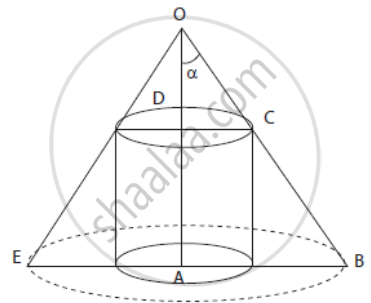Advertisements
Advertisements
प्रश्न
Show that height of the cylinder of greatest volume which can be inscribed in a right circular cone of height h and semi-vertical angle α is one-third that of the cone and the greatest volume of the cylinder is `(4)/(27) pi"h"^3 tan^2 α`.
उत्तर

Let CD = R, AD = x
⇒ OD = h - x
∵ ODC ∼ ΔOAB
⇒ `(h - x)/h = R/"AB" ⇒ (h - x)/h = R/(h tan α)`
⇒ R = (h - x) tan α
V = πR2x
= π(h - x)2 tan2α. x
= π tan2α (h - x)2x
`dV/dx = π tan2α (h2 - 4hx + 3x2)`
`dV/dx = 0 = h^2 - 4hx + 3x^2 = 0`
⇒ (h - x)(h - 3x) = 0
⇒ x = h (not possible ) or x =` h/3`
`(d^2V)/(dx^2) = π tan^2α (-4h + 6x)`
`((d^2V)/(dx^2))_(x = h/3) = π tan^2α (-2h) < 0`
⇒ V is maximum for x = `h/3`.
So, Vmax = π tan2α (h - x)2x
`= π tan^2α ( h - h/3 )^2 h/3`
= `(4πh)^3/27 tan^2 a`
APPEARS IN
संबंधित प्रश्न
f (x) = x2/3 on [−1, 1] Discuss the applicability of Rolle's theorem for the following function on the indicated intervals ?
\[f\left( x \right) = \begin{cases}- 4x + 5, & 0 \leq x \leq 1 \\ 2x - 3, & 1 < x \leq 2\end{cases}\] Discuss the applicability of Rolle's theorem for the following function on the indicated intervals ?
Verify Rolle's theorem for the following function on the indicated interval f (x) = (x − 1) (x − 2)2 on [1, 2] ?
Verify Rolle's theorem for each of the following function on the indicated interval f (x) = cos 2 (x − π/4) on [0, π/2] ?
Verify Rolle's theorem for the following function on the indicated interval f(x) = cos 2x on [−π/4, π/4] ?
Verify Rolle's theorem for the following function on the indicated interval f(x) = ex sin x on [0, π] ?
Verify Rolle's theorem for the following function on the indicated interval f (x) = \[{e^{1 - x}}^2\] on [−1, 1] ?
Verify Rolle's theorem for the following function on the indicated interval \[f\left( x \right) = \frac{6x}{\pi} - 4 \sin^2 x \text { on } [0, \pi/6]\] ?
Verify Rolle's theorem for the following function on the indicated interval f(x) = 4sin x on [0, π] ?
Verify Rolle's theorem for the following function on the indicated interval f(x) = sin4 x + cos4 x on \[\left[ 0, \frac{\pi}{2} \right]\] ?
Verify Rolle's theorem for the following function on the indicated interval f(x) = sin x − sin 2x on [0, π]?
At what point on the following curve, is the tangent parallel to x-axis y = x2 on [−2, 2]
?
At what point on the following curve, is the tangent parallel to x-axis y = 12 (x + 1) (x − 2) on [−1, 2] ?
Verify Lagrange's mean value theorem for the following function on the indicated intervals. find a point 'c' in the indicated interval as stated by the Lagrange's mean value theorem f(x) = x(x −1) on [1, 2] ?
Verify Lagrange's mean value theorem for the following function on the indicated intervals. find a point 'c' in the indicated interval as stated by the Lagrange's mean value theorem f(x) = x2 − 3x + 2 on [−1, 2] ?
Verify Lagrange's mean value theorem for the following function on the indicated intervals. find a point 'c' in the indicated interval as stated by the Lagrange's mean value theorem \[f\left( x \right) = x + \frac{1}{x} \text { on }[1, 3]\] ?
Show that the lagrange's mean value theorem is not applicable to the function
f(x) = \[\frac{1}{x}\] on [−1, 1] ?
Verify the hypothesis and conclusion of Lagrange's man value theorem for the function
f(x) = \[\frac{1}{4x - 1},\] 1≤ x ≤ 4 ?
Find a point on the parabola y = (x − 4)2, where the tangent is parallel to the chord joining (4, 0) and (5, 1) ?
Find a point on the parabola y = (x − 3)2, where the tangent is parallel to the chord joining (3, 0) and (4, 1) ?
The value of c in Rolle's theorem when
f (x) = 2x3 − 5x2 − 4x + 3, x ∈ [1/3, 3] is
The value of c in Lagrange's mean value theorem for the function f (x) = x (x − 2) when x ∈ [1, 2] is
The value of c in Rolle's theorem for the function f (x) = x3 − 3x in the interval [0,\[\sqrt{3}\]] is
The maximum value of sinx + cosx is ______.
At what point, the slope of the curve y = – x3 + 3x2 + 9x – 27 is maximum? Also find the maximum slope.
The least value of the function f(x) = 2 cos x + x in the closed interval `[0, π/2]` is:
Let y = `f(x)` be the equation of a curve. Then the equation of tangent at (xo, yo) is :-
